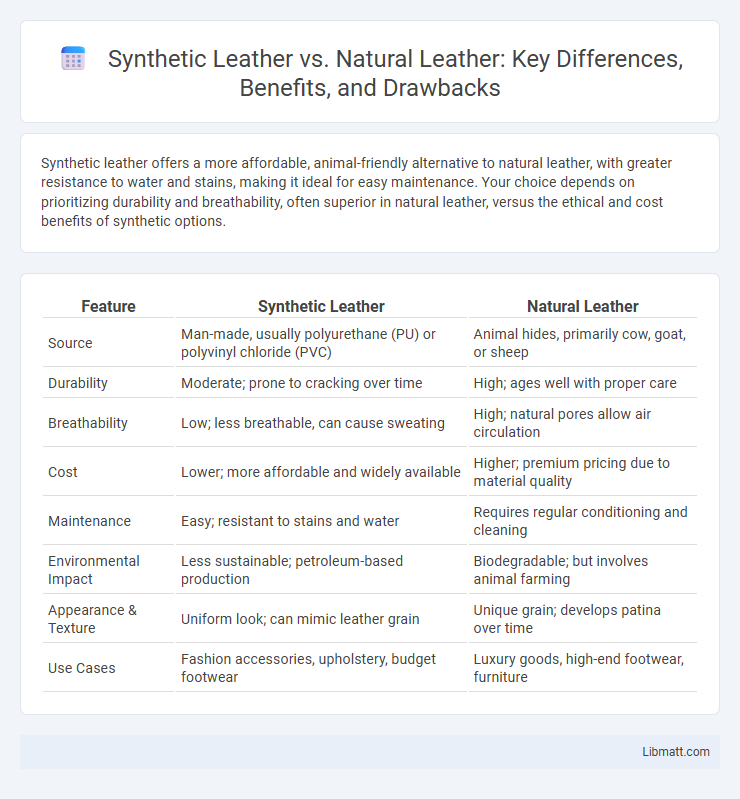Synthetic leather offers a more affordable, animal-friendly alternative to natural leather, with greater resistance to water and stains, making it ideal for easy maintenance. Your choice depends on prioritizing durability and breathability, often superior in natural leather, versus the ethical and cost benefits of synthetic options.
Table of Comparison
| Feature | Synthetic Leather | Natural Leather |
|---|---|---|
| Source | Man-made, usually polyurethane (PU) or polyvinyl chloride (PVC) | Animal hides, primarily cow, goat, or sheep |
| Durability | Moderate; prone to cracking over time | High; ages well with proper care |
| Breathability | Low; less breathable, can cause sweating | High; natural pores allow air circulation |
| Cost | Lower; more affordable and widely available | Higher; premium pricing due to material quality |
| Maintenance | Easy; resistant to stains and water | Requires regular conditioning and cleaning |
| Environmental Impact | Less sustainable; petroleum-based production | Biodegradable; but involves animal farming |
| Appearance & Texture | Uniform look; can mimic leather grain | Unique grain; develops patina over time |
| Use Cases | Fashion accessories, upholstery, budget footwear | Luxury goods, high-end footwear, furniture |
Introduction: Understanding Synthetic and Natural Leather
Synthetic leather, crafted from plastic-based materials like polyurethane or polyvinyl chloride (PVC), offers a durable and affordable alternative to natural leather derived from animal hides. Natural leather boasts breathability, unique texture, and longevity, while synthetic leather excels in water resistance and ethical sourcing without compromising appearance. Your choice depends on priorities such as environmental impact, maintenance, and budget when comparing synthetic vs natural leather.
Key Differences Between Synthetic and Natural Leather
Synthetic leather is manufactured from plastic-based materials such as polyvinyl chloride (PVC) or polyurethane (PU), offering greater resistance to water, stains, and general abrasion compared to natural leather, which is derived from animal hides and features a unique grain pattern and breathability. Natural leather undergoes processes like tanning and finishing, providing durability, flexibility, and the ability to develop a distinct patina over time, while synthetic leather maintains a consistent appearance but typically lacks the same aging qualities. Cost-wise, synthetic leather tends to be more affordable and environmentally less demanding upfront, although natural leather's biodegradability and longevity offer benefits for sustainable usage.
Material Composition and Manufacturing Process
Synthetic leather is primarily made from polyurethane (PU) or polyvinyl chloride (PVC) layered over a fabric base, produced through chemical processes that mimic the appearance of natural leather. Natural leather is derived from animal hides, mainly cowhide, and undergoes tanning involving natural or synthetic agents to preserve durability and suppleness. The manufacturing of synthetic leather emphasizes uniformity and water resistance, whereas natural leather production prioritizes breathability and unique texture variations.
Durability and Longevity Comparison
Synthetic leather offers enhanced durability due to its resistance to water, stains, and fading, making it less prone to cracking or peeling over time compared to natural leather. Natural leather, while susceptible to scratches and wear, can develop a unique patina that adds to its character and longevity when properly maintained. Your choice between synthetic and natural leather depends on whether you prioritize low-maintenance durability or the authentic aging process and natural breathability of traditional leather.
Environmental Impact: Sustainability and Eco-Friendliness
Synthetic leather generally has a lower environmental impact in terms of animal welfare but relies heavily on petroleum-based materials, contributing to pollution and non-biodegradability. Natural leather, while biodegradable and durable, involves significant resource consumption, including water, land, and chemicals used in tanning processes that can cause environmental contamination. Sustainable alternatives such as plant-based or recycled synthetic leather aim to reduce carbon footprints and waste, promoting eco-friendliness across the leather industry.
Cost Analysis: Pricing of Synthetic vs Natural Leather
Synthetic leather typically costs 30-50% less than natural leather, making it a budget-friendly option for consumers seeking affordable alternatives. Natural leather prices vary significantly, often ranging from $15 to $100 per square foot depending on quality and origin, while synthetic leather usually falls between $5 to $20 per square foot. The durability and longevity of natural leather may justify its higher initial cost by reducing long-term replacement expenses.
Aesthetic Appeal and Texture
Synthetic leather offers a consistent aesthetic appeal with a smooth texture that resists scratches and stains, making it ideal for maintaining a flawless look over time. Natural leather provides a unique, rich patina and supple texture that develops character with age, enhancing its luxurious appearance. Choosing synthetic leather ensures uniformity and easy maintenance, while natural leather delivers authenticity and a tactile experience that evolves with use.
Maintenance and Care Requirements
Synthetic leather requires minimal maintenance, typically needing only regular wiping with a damp cloth to remove dirt and spills, and it resists stains and water better than natural leather. Natural leather demands more intensive care, including conditioning with specialized leather creams to prevent drying and cracking, as well as protection from excessive moisture and direct sunlight. Proper maintenance of natural leather extends its durability and preserves its texture, while synthetic leather offers easier upkeep but may have a shorter lifespan under heavy use.
Common Applications and Uses
Synthetic leather is widely used in automotive upholstery, fashion accessories, and furniture due to its affordability, water resistance, and ease of maintenance. Natural leather dominates luxury goods, high-end footwear, and premium upholstery applications for its breathability, durability, and unique aging properties. The choice between synthetic and natural leather often depends on factors like budget, desired texture, and environmental considerations in industries such as fashion, interior design, and automotive manufacturing.
Choosing the Right Leather: Factors to Consider
When choosing between synthetic leather and natural leather, consider durability, maintenance, cost, and environmental impact. Natural leather offers superior breathability and ages uniquely, while synthetic leather provides water resistance and easier cleaning. Your choice should align with your lifestyle, budget, and ethical preferences to ensure satisfaction and longevity.
Synthetic leather vs natural leather Infographic

 libmatt.com
libmatt.com